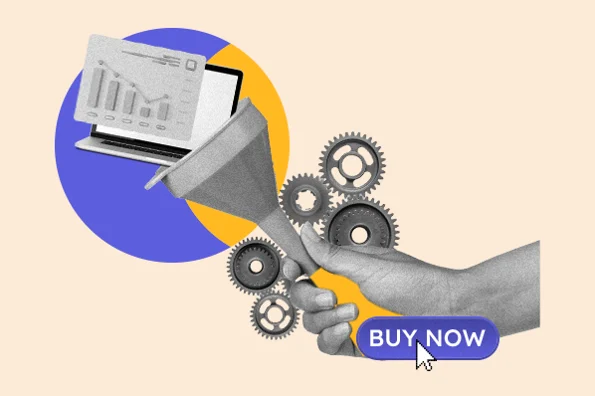Knowing how important your salespeople are, you’ve put a great deal of effort, time, and money into hiring the best and training them. You’ve even put time into crafting your sales process, ensuring that customers are guided gently and intentionally through their journey — a journey that leads them directly to signing on the dotted line.
Yet lately, something has been off. Your salespeople aren’t closing the number of deals you expect. The leads for potential customers start out great, yet they aren’t making it through the sales process. You can’t help but feel frustrated with your team. They’re obviously doing something wrong, something that is jeopardizing your company’s ability to grow and thrive.
Or are they?
Sure, your salespeople may have areas they can improve upon, but there’s an equally good chance that your company is experiencing a sales bottleneck.
Whether you’re new to business or a seasoned manager or salesperson, you’ve probably experienced a sales bottleneck. Just like a bottleneck during rush-hour traffic, a sales bottleneck is a part of the selling process that slows down the flow and has the potential to bring your sales to a screeching halt.
This situation can be caused by two different issues. Either there is a problem with your sales process itself, or your salespeople are not carrying out that process correctly. Either one of these will cause the same issue — slow or no sales.
If most of your sales team is crushing their goals, except for one salesperson who appears to be floundering, the issue is probably with that individual. However, if there is something wrong with the sales process itself, you’ll see the impact across your entire sales team. Some may be affected more, but all will see signs of slowing.
When you see signs of slowing that aren't related to seasonality or other justifiable factors, you need to identify the bottleneck quickly and take steps to fix it before the situation becomes worse.
How To Fix a Sales Bottleneck
There are a number of issues that can cause a sales bottleneck, however before you can fix a bottleneck you must be able to correctly identify it.
Let’s go through some general guidelines for fixing a bottleneck, then we’ll take a look at a few of the common sales bottlenecks and provide some tips for how to correct them.
In order to correct a sales bottleneck, you must:
1. Understand how your sales process works.
While you may not have consciously created this process when you began selling, it may have developed over time without your input. If you are familiar with the steps a customer goes through when purchasing your product, write them down.
If you are not familiar with these steps, ask one of your reps to role-play with you and take you through the process step-by-step. Write everything down to review after.
2. Review the process as it currently functions.
Now that you’ve got your process down on paper, do a quick review for any issues that jump out right away. Sometimes, the problems are so obvious, you’ll be surprised you didn’t see them sooner.
3. Get input from your reps.
Your sales reps are working in your sales process day in and day out. Ask them to identify how far they get into a sale before they hit a roadblock or it falls apart completely. Make note if they are all experiencing issues at the same step.
4. Ask your customers for feedback.
Talk to your existing customers, and if you have access to a potential customer that chose not to buy, check in with them too. Find out what was difficult for them and what encouraged them to buy anyway or walk away.
7. Create a plan.
Gather your data and create a plan. The solution may be obvious depending on the issue, or it may take a little bit of trial and error to fix. Reevaluate after every few sales attempts until your sales process is running like a well-oiled machine.
Types of Sales Bottlenecks
Now, let’s take a look at some common bottlenecks and how they can be fixed.
1. Too much time spent on non money-making activities.
Do your salespeople have other (non-sales related) responsibilities that take time away from what they are there to do? Or are they required to keep redundant logs or run reports that could be handled more expeditiously or by someone else?
Consider re-thinking your sales enablement approach to streamline tedious tasks for your reps, and free them up to focus on money-making activities.
2. Too many steps (and hands) in the sales process.
Does your sales process make it difficult for your customers to buy? Perhaps they have to jump through hoops or the deal must pass through multiple hands (whose entire focus may not be closing deals) before it can be finalized.
Examine your process for unnecessary steps and consider a trial run of removing a few that appear unnecessary. If possible, empower your salespeople to handle more steps on their own so others don’t need to be involved.
3. Complex pricing structures.
Quoting (or understanding) a deal should not require a degree in rocket science. If there are too many factors that play into a proposal, your salespeople will be frustrated and your potential customer will be tired of waiting.
Consider simplifying your pricing structure so proposals can go out quickly and are easy for your customers to understand.
4. Not utilizing technology properly.
Businesses today have so much technology at their fingertips. From CRMs to collaboration tools, there’s no excuse for time wasted using old methods of data collection or communication.
If you have multiple systems that don’t work well together or require endless integrations that are always breaking, it could be a good time to streamline the systems your team uses.
5. Approval delays.
Your salespeople may be doing everything in their power to facilitate a deal. However, if there’s another department involved (perhaps one whose compensation does not depend on their output), your sales process may hit a wall when it reaches them.
You may want to consider motivating that department with bonuses or eliminating that step for deals below a certain amount.
6. Lack of post-sale communication.
Just because money has been exchanged, doesn’t mean the sales process is over. If you handle follow-up correctly, It’s much easier to get an existing customer to buy more or buy again than it is to attract a new customer.
Make sure customers are being contacted after the sale has closed. This may include thank you cards, automated emails, survey requests, or a follow-up call a few weeks later to see how they are enjoying your product. Without this, you may be creating a bottleneck to your next sale.
How To Prevent a Sales Bottleneck
Like anything in life and business, prevention is the best medicine. If you can prevent a sales bottleneck before it starts, you’ll lose less time and money than if you have to fix one already in play.
Here are some ways you can prevent a sales bottleneck:
- Take the time to craft your sales process and your sales funnel, rather than letting it happen organically.
- Prequalify leads so the wrong “potential customers” don’t end up in your funnel.
- Keep your list clean by removing inactive leads who show no promise of becoming customers.
- Avoid creating redundant steps by streamlining your process whenever possible.
- Provide your sales team with support in the form of systems and proper training.
- Utilize technology whenever possible to maintain your leads, communicate with your team, and follow up once the sale is complete.
- Investigate an issue the moment it occurs instead of chalking it up to something else or assuming it will fix itself.
While sales bottlenecks are painful at the moment, they present the opportunity to revitalize your sales process, identify ways you can coach your salespeople, and improve your business in the long run. For advice on refining your sales process, check out this post.
Sales Process

.jpg)


![Want to Create a Sales Plan? Let Me Show You How [+ 10 Sales Plan Examples]](https://53.fs1.hubspotusercontent-na1.net/hubfs/53/how-to-create-a-sales-plan-1.jpg)
![The Ultimate Sales Cheat Sheet Template to Help Boost Rep Success [New Data + Templates]](https://53.fs1.hubspotusercontent-na1.net/hubfs/53/ft-cheat.webp)
![How to use battle cards in your sales process [+ templates]](https://53.fs1.hubspotusercontent-na1.net/hubfs/53/%5BUse-Oct-08-2025-10-11-09-0787-PM.webp)



.jpg)

